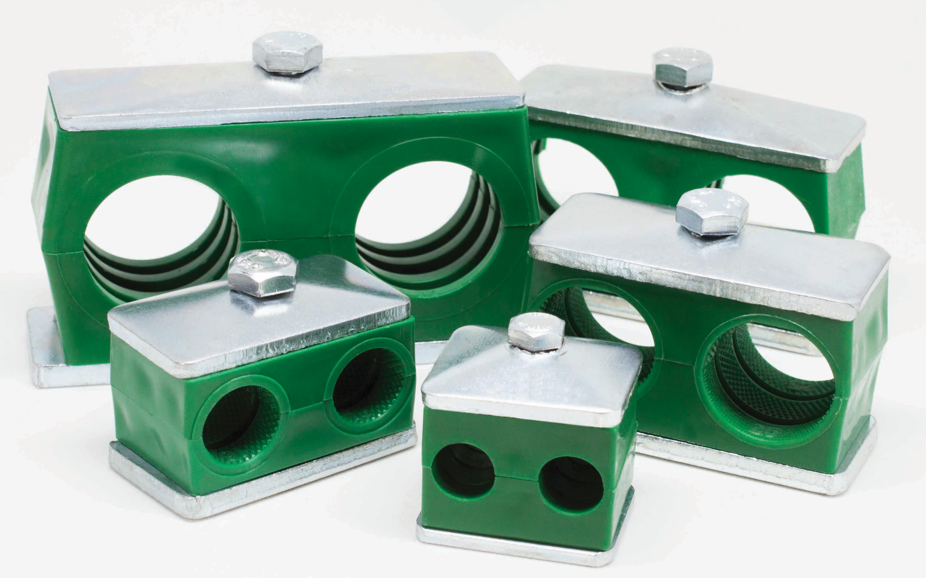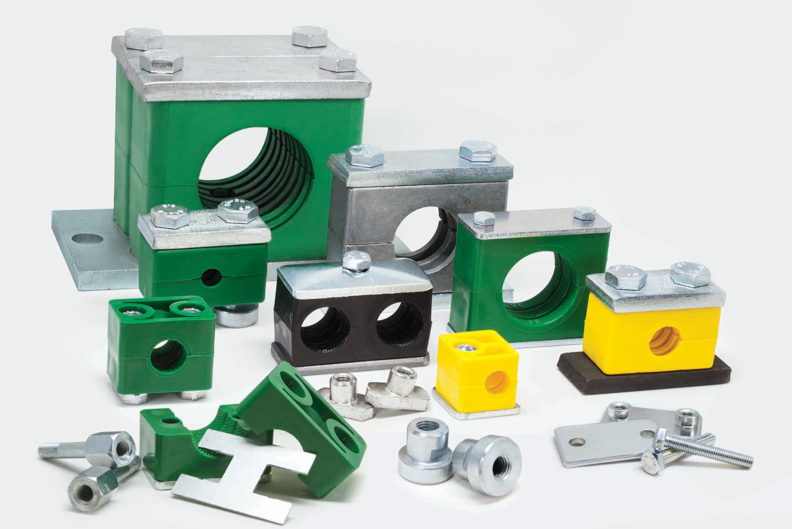Secure Your System – All You Need to Know About Hydraulic Tube Clamps
What are hydraulic pipe clamps used for?
Hydraulic pipe clamps also known as hydraulic tube clamps are used to secure, support, and stabilize pipes, hoses, and tubes that carry fluids in hydraulic systems. They're an essential part of managing hydraulic lines, especially in high-pressure environments like construction equipment, manufacturing plants, and industrial machinery.

What types of hydraulic pipe clamps are there?
1. Light-Duty Clamps
-
Material: Usually made from polypropylene or polyamide (nylon).
-
Use: Low-pressure systems, general-purpose hydraulic lines.
-
Features: Cost-effective, easy to install, vibration-dampening.
2. Heavy-Duty Clamps
-
Material: Polypropylene, aluminium inserts, or rubber with steel mounting hardware.
-
Use: High-pressure hydraulic systems, such as in industrial machinery or mobile equipment.
-
Features: Excellent vibration resistance, durable, designed for higher loads and stresses.
3. Twin (Double) Clamps
-
Material: Same as above (polypropylene or aluminium).
-
Use: For securing two parallel pipes or hoses.
-
Features: Space-saving, helps keep lines organized and symmetrical.
What materials are hydraulic pipe clamps made from?
Plastic/Polymer Materials - These are commonly used for low to medium-pressure application
- Polypropylene (PP) - Typically green in colour, these clamps are made from polypropylene and are used in standard hydraulic systems. They offer good chemical resistance, are cost-effective, and are suitable for light-duty applications with a temperature range of -30°C to +90°C (-22°F to +194°F).
- Polyamide (PA / Nylon) - These clamps are usually black in colour and made from polyamide (nylon), designed for higher temperatures or UV exposure. With a temperature range of -40°C to +120°C (-40°F to +248°F), they are tougher than polypropylene and ideal for outdoor use.
- Polyamide (PA / Nylon) - These clamps are usually black in colour and made from polyamide (nylon), designed for higher temperatures or UV exposure. With a temperature range of -40°C to +120°C (-40°F to +248°F), they are tougher than polypropylene and ideal for outdoor use.
- Thermoplastic Elastomer (TPE) / Rubber - These clamps are used for vibration and noise damping. They are flexible, cushion the pipe, and are often used as inserts in metal clamps to reduce vibration and noise in hydraulic systems
Metal Materials - Used for medium to heavy-duty and high-temperature or pressure environments.
- Aluminium - These clamps are designed for high heat, heavy vibration, or chemically aggressive environments. They are strong, corrosion-resistant, and commonly used in heavy-duty applications. Temperature Range: -50°C to +150°C (-58°F to +302°F)
- Carbon Steel - These clamps are used for structural support, saddle clamps, and U-bolts. They are very strong and require a coating (such as zinc-plating or paint) to resist corrosion. Temperature Range: -20°C to +150°C (-4°F to +302°F)
- Stainless Steel (304/316) - These clamps are used in marine, chemical, or hygienic environments. They offer excellent corrosion resistance, are long-lasting, but tend to be more expensive. Temperature Range: -200°C to +550°C (-328°F to +1022°F), depending on the grade of stainless steel.

How do I size a hydraulic pipe clamps?
Sizing a hydraulic pipe clamp involves matching the clamp to the diameter of the pipe or hose and ensuring it can handle the system's pressure, temperature, and vibration conditions.
Pipe or Hose Diameter
-
The most important measurement is the outer diameter (OD) of the pipe or hose that the clamp will secure.
-
How to Measure: Use a calliper or measuring tape to measure the outside diameter of the pipe or hose at the location where the clamp will be installed.
-
Clamp Sizing: Choose a clamp size that matches the outer diameter of the pipe, ensuring it fits snugly without being too tight (which could cause deformation) or too loose (which could cause slippage).
Pipe Material and Thickness
-
For certain materials (like thick-walled pipes), the wall thickness might affect the clamp sizing.
-
Ensure that the clamp’s design can handle the material of the pipe, especially if it’s reinforced or has a special coating.
Clamp Type (Design Considerations)
-
Single or Double Clamp: For systems where two parallel pipes need securing, a twin clamp or double clamp might be necessary.
-
Vibration Damping: If you need to reduce vibration, look for clamps with rubber or elastomer inserts, which cushion the pipe and reduce wear.
-
Mounting Style: Depending on the installation, you may need saddle clamps, U-bolt clamps, or rail-mount clamps. Make sure the clamp design fits the mounting setup.
Temperature Resistance
-
Consider the operating temperature of the hydraulic system. Choose a clamp made from materials that can handle the high or low temperatures your system may experience (e.g., rubber inserts for vibration damping might not handle extreme temperatures).
-
Example: If working in high-heat environments, clamps made from stainless steel or polyamide will offer better performance.
Are hydraulic pipe clamps compatible with all hydraulic systems?
While hydraulic pipe clamps are broadly compatible with most hydraulic systems, choosing the right type requires considering pressure, temperature, vibration, material, and environmental conditions. Always select a clamp that matches the specific requirements of your hydraulic system for optimal performance and safety.
Can I use hydraulic pipe clamps for high-pressure applications?
Yes, hydraulic pipe clamps can be used for high-pressure applications, but they need to be properly rated and designed for such use.
How do I install hydraulic pipe clamps?
- Prepare the Area: Clear the installation area of debris.
- Select the Right Clamp: Choose a clamp that matches the pipe size and pressure requirements.
- Position the Pipe: Place the pipe where it needs to be installed, ensuring it’s properly aligned and supported.
- Install the Clamp: Open the clamp and position it around the pipe. Adjust if necessary for the correct size (for adjustable clamps).
- Tighten the Clamp: Secure the clamp by tightening the bolts or screws (follow the torque specifications). Ensure the clamp is evenly tight on all sides to hold the pipe securely.
- Connect Hydraulic Pressure: Attach the hydraulic line to the clamp's fitting. Slowly apply hydraulic pressure to tighten the clamp around the pipe.
- Check for Leaks: Once the clamp is tightened, inspect the installation for any fluid leaks. If you see any leaks, fix them before continuing.
- Test the System: Fully pressurize the system and check that the pipe stays secure and the clamp holds properly
- Final Checks: Ensure all bolts are tightened and there’s no movement in the pipe.
Do I need to maintain hydraulic pipe clamps?
Yes, maintenance is essential for hydraulic pipe clamps to ensure they continue to function effectively, especially in high-pressure systems. Proper maintenance can extend the life of the clamps and prevent unexpected failures.
Can hydraulic pipe clamps be reused?
Hydraulic clamps can be reused, but only if they are in good condition. Regular inspection, proper maintenance, and replacing worn or damaged parts are critical to ensure the clamp’s safety and effectiveness in subsequent uses.
Are there industry standards for hydraulic pipe clamps?
The most common industry standards for hydraulic pipe clamps is DIN 3015. This is one of the most widely used standards for clamping elements used with pipes and tubes, including hydraulic pipe clamps. It specifies how clamps should be designed, the types of materials used, and provides dimensional guidelines for different pipe sizes.

Why Buy Hydraulic Pipe Clamps from Flowfit?
- Premium Quality: Flowfit’s hydraulic clamps are made from top-grade materials, ensuring long-lasting durability and exceptional performance in even the most demanding applications.
- Comprehensive Range: We offer a wide selection of materials and sizes to suit your specification.
- Customisable Solutions: Flowfit provides tailored power units that meet the unique specifications of your equipment and industry.
- Free UK Shipping: We offer free UK shipping on orders over £250, making it easier and more affordable to get the hydraulic components you need delivered straight to your door.
- Global Shipping: Flowfit proudly serves customers across the UK and worldwide, ensuring that top-quality hydraulic products are available no matter where you are.
Browse our selection of hydraulic pipe clamps and find the ideal hydraulic solution for your needs. Our team of hydraulic specialists are ready to assist you with expert advice and help you find the best products for your equipment.
For more information, get in touch with our team of hydraulic specialists today!
The total one-stop supplier for hydraulic components & systems
Get in touch
Parys Road
Ludlow
Shropshire
SY8 1XY








